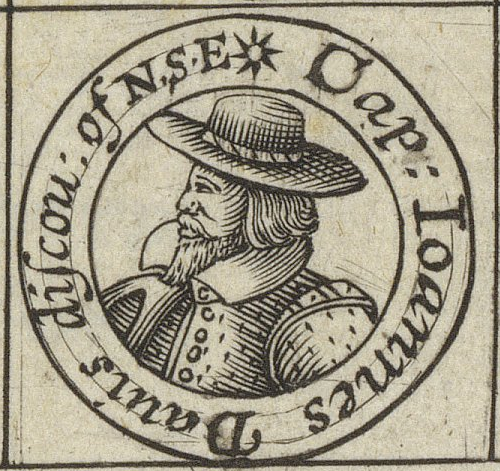Martin Frobisher failed in his attempt to extract wealth from Arctic Canada in the 1570s, but England’s passion remained strong for finding a Northwest Passage to China. John Davis would be the next in line to make that quest in three missions between 1585 and 1587.
On his first voyage, Davis left Dartmouth on 7 June 1585 with two ships, the Sunshine (50 tons, 23 crew, including a four-man band) and Moonshine (35 tons, 19 crew). The trip was backed by William Sanderson and a group of merchants from London and the West Country.
After battling strong westerly winds, the two ships arrived on the west coast of Greenland and dropped anchor at the present site of Nuuk. Here, they had a most pleasing interaction with the local Inuit. The encounter began with the crew hearing a “lamentable noise” that they thought must be wolves. It turned out to be the Inuit’s making a ruckus to get their attention. In response, the crew went on shore with their band, which began to play while the officers and sailors danced and “allured the Inuit by friendly embraces and signs of courtesy.” (Markham, 1980). The sailors then placed some stockings, caps, and gloves on the ground as gifts and danced and sang their way back into their boats and rowed back to the mother ships.
This strange behavior apparently proved effective, and the next day, the Inuit came back and actively traded with them. Despite Frobisher’s previous altercations with them, the Inuit reacted quite favorably towards Davis and his crew. As Davis’s chronicler, Jayne tells the story:
“The ships being within tile sounds, we sent our boats to search for shole water, where we might anchor, which in this place is very hard to find: and as the boat went sounding and searching, the people of the country having spied them, came in their canoes towards them with many shoutsand cries: but after they had spied in the boat, some of our company that was the year before here with us, they presently rowed to the boat, and took hold in the oar, and hung about the boat with such comfortable joy as would require a long discourse to be uttered: they came with the boats to our ships, making signs that they all those that yere before had been with them.
After I perceived their joy … myself with the merchants and others of the company went ashore, bearing with me twenty knives. I had no sooner landed, but they leaped out of their canoes and came running to me and the rest and embraced us with many signs of hearty welcome: at this present, there were eighteen of them, and to each of them, I gave a knife: they offered skins to me for reward, but I made signs that it was not sold, but given them of courtesy: and so dismissed them for that time, with signs that they should return again after certain hours.
The next day, with all possible speed, the pinnace was landed upon an Isle there to be finished … During the time that the pinnace was there setting up, the people came continually unto us, sometimes a hundred canoes at a time, sometimes forty, fifty, more and Jess, asoccasion served. They brought with them sealskins, stag skins, white hares, seal fish, salmon, small cod, dry caplin, with other fish, and birds, such as the country did yield.” (Markham, 1880: 16).
The expedition then sailed west across the cold, icy waters of what is now called Davis Strait and discovered a wide and deep sound that Davis was certain was the opening to the Northwest Passage. They sailed for miles into this waterway (now called Cumberland Gulf), but by August 20th, the blustery wintry winds convinced Davis and his officers that they had better turn and head home or risk spending the winter icebound. Unbeknownst to them, they had not gone far enough to find that the waterway was not the Passage at all but, in fact, ended in the center of Baffin Island.
Davis and crew arrived back at Dartmouth on the 30th of September. On his return, Davis immediately wrote a letter to Sir Frances Walsingham Knight, a member of Her Majesty’s Privy Council, in which he enthusiastically boasted he had found the Northwest Passage: “Right honorable most dutifully craving pardon for this my rash boldness, I am herby, according to my duty, to signify to your honor that the north-west passage is a matter nothing doubtful! but at any time almost to be passed, the sea navigable, the air tolerable, and the waters very deep. I have also found a very great quantity, not in any globe or map described, yielding a sufficient trade of fur and leather. Although this passage hath been supposed very impassible, yet through God’s mercy, I am in experience and eye witness to the contrary, yea in this most desperate climate; which, by Gods help, I will very shortly most at large reveal onto your honor so soon as I can possibly take orders for my mariners and shipping. Thus, depending on your honors good favor, I humbly commit you to God this third of October.” (Markham, 1880: xix).
Illustration: A miniature portrait (1624) of John Davis from the title page of Samuel Purchas’s collection of travel stories, Hakluytus Posthumus or Purchas his Pilgrimes.
Bibliography
Markham, A. H. (ed.) (1880) The voyages and works of John Davis, the navigator. London: The Hakluyt Society.
Markham, C. R. (1889). The life of John Davis, the navigator (1550 – 1605). Discoverer of the Davis Straits. Dodd Mead and Company, New York.
